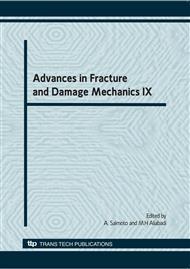p.625
p.629
p.633
p.637
p.641
p.645
p.649
p.653
p.657
Suppression of Fatigue Crack Growth in Austenite Stainless Steel by Cavitation Peening
Abstract:
Cavitation normally causes severe damage in hydraulic machinery such as pumps and turbines by the impact produced by cavitation bubbles collapsing. Although cavitation is known as a factor of erosion, Soyama et al. succeeded in utilizing impacts of cavitation bubble collapsing for surface modification by controlling cavitating jet in the same way as shot peening. The local plastic deformation caused by cavitation impact enhances the fatigue strength of metallic materials, and the surface modification technique utilizing cavitation impact is called “cavitation peening (CP)”. It is well known that the peening improves fatigue strength by introducing compressive residual stress on the surface, but little attention has been paid to the behavior of fatigue crack growth of the material which was modified by CP. In the present study, the fatigue behavior of austenite stainless steel with and without CP was evaluated by a plate bending fatigue test, and the results revealed that the compressive residual stress introduced by CP suppresses fatigue crack growth rate by 70 % compared to that without CP.
Info:
Periodical:
Pages:
641-644
Citation:
Online since:
November 2010
Authors:
Price:
Сopyright:
© 2011 Trans Tech Publications Ltd. All Rights Reserved
Share:
Citation:


